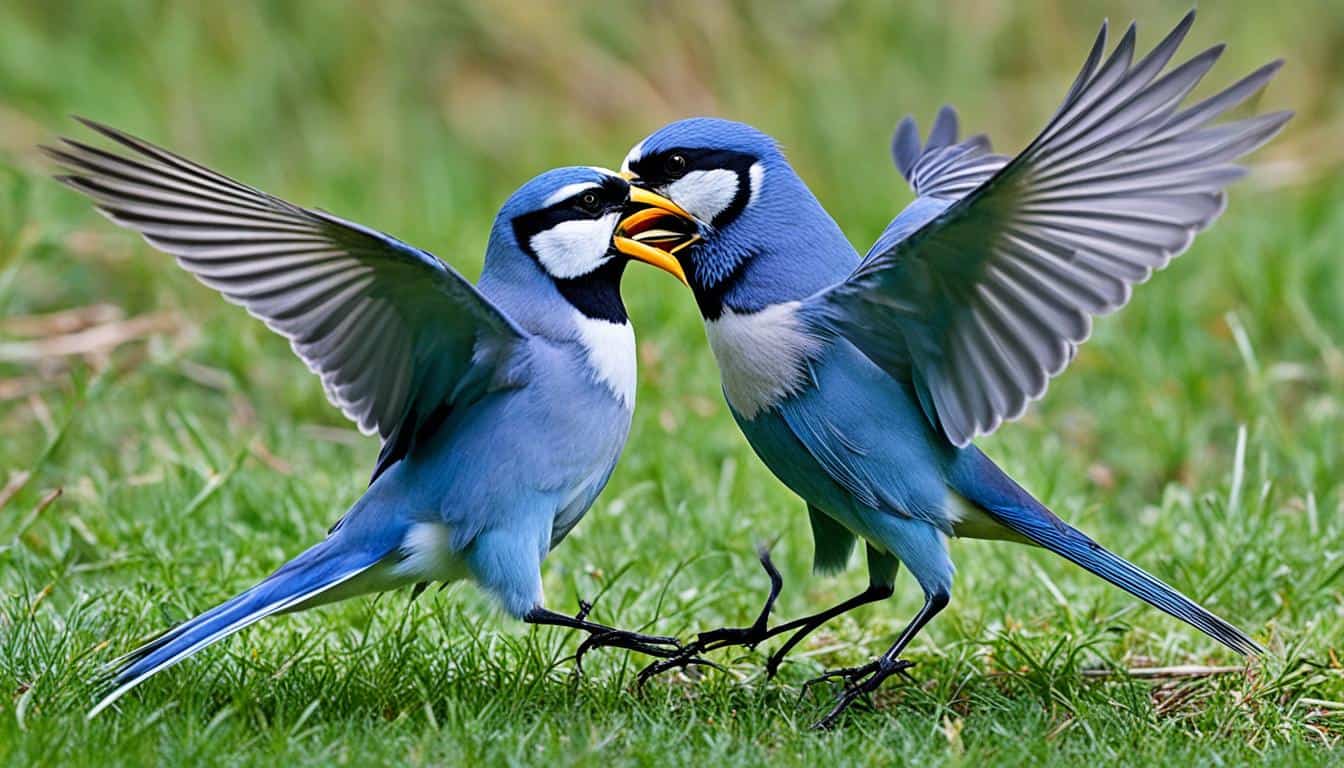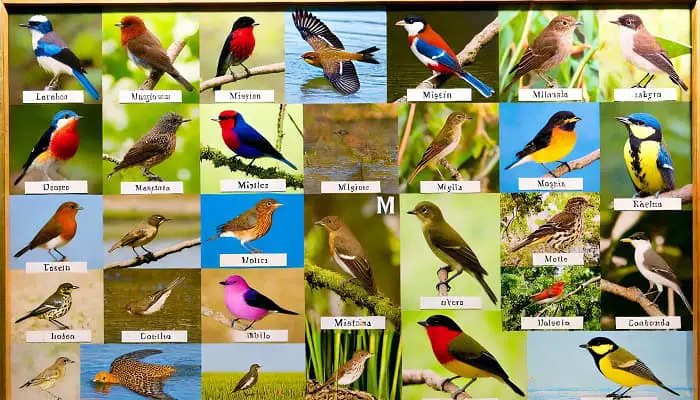Birds Fighting or Mating: How to Tell the Difference
Have you ever seen birds that look like they’re really fighting or mating? Then you start to wonder if it’s something else, like mating? Why are birds so aggressive towards each other? This situation can be quite puzzling. Sometimes, it’s hard to tell if birds’ actions are because of aggression or if they’re trying to find a mate. This article aims to help you understand the difference.
What does it mean when birds fight? Some might think the birds are out to kill each other. But there’s often a lot more going on. By picking up on the small signs in their behavior, you can see if it’s a true fight or a mating ritual. Let’s explore how to make sense of birds fighting or mating, making you better understand birds you see.
Bird Behavior: Aggressive or Courtship?
It’s tricky to tell if birds are fighting or flirting. They both might puff up their feathers, move their wings oddly, and make lots of noise. But, watching how they act and their feathers can help us know what’s really going on.
Observing Body Movements and Feather Displays
Aggressive bird behavior can look intense. The birds might puff out their feathers, raise their neck feathers, and flap their wings fast and suddenly. They might even push each other around or touch beaks. On the other hand, birds showing courtship behavior usually look smooth and glide their wings softly.
- Aggressive birds might show their wings wide, trying to look big and scary. But courting birds usually keep their wings folded at their sides.
- Aggressive birds might quickly move their head or body toward another bird, showing they’re ready to fight. But courtship birds move gracefully together.
- Feather displays of angry birds could be messy and all over the place. In contrast, birds that are courting might show off perfectly coordinated and beautiful feather displays.
Watching how birds use their bodies and feathers tells us a lot. We can figure out if they’re arguing over space or trying to find a mate by these clues.
“The dance of courtship is one of the most captivating and elaborate performances in the natural world.” – David Attenborough
Learning these signals lets us see the beauty of bird behavior close to home or in a park. Whether they seem at war or are dancing elegantly, we connect more with their world.
Decoding Bird Sounds: Squawks vs. Songs
There’s a wealth of information in bird sounds, from aggressive bird calls to captivating mating bird calls. They give us valuable insights into what our feathered friends are up to. Initially, their bird vocalizations might sound like a mix of chirps and tweets. Yet, paying close attention reveals the rich details of bird communication right in front of us.
Squawks and screeches that are loud and harsh point to fights over territory or pure aggression. In these aggressive bird calls, birds are showing they mean business and are ready to defend their space. On the other hand, soft songs and gentle chirps hint at courtship and mating events. With these mating bird calls, birds try to attract mates and build stronger bonds.
By focusing on bird vocalizations, you can tell if birds are fighting or flirting. This insight into bird communication deepens our connection with nature. It highlights the intricate social life happening all around us.
“The language of birds is very ancient, and, like fossil tracks on the geological record, it tells of the long sessions of adaptation and creativity that lie behind the forms, lives, and needs of each species today.” – Loren Eiseley
Next time you hear a cacophony of squawks or a serenade of songs in your backyard, pay close attention. Those bird sounds might be the key to understanding bird behavior and the incredible bird communication world.
Birds Fighting or Mating: Seasonality Matters
It’s not always easy to tell if birds are fighting or mating. But, the time of year gives us big hints. Look at the birds in your yard and think about the season. This helps figure out what they’re up to.
Spring Courtship or Year-Round Territorial Disputes?
In spring, birds are busy finding mates and claiming their areas. Mating season means seeing fancy dances, soft pecks, and nests being built. After spring, birds often fight to keep their space safe from others.
Knowing the time of year shows if birds are protecting their spots or looking for love. This is key to understanding why birds act the way they do.
| Behavior | Spring (Mating Season) | Outside of Spring |
|---|---|---|
| Primary Motivation | Courtship and Reproduction | Territorial Disputes |
| Common Interactions |
|
|
| Typical Outcome | Successful Mating and Reproduction | Maintaining Exclusive Territory |
Understanding bird behavior in the context of seasons helps tell when they mate or fight. This knowledge brings us closer to appreciating how birds live.
Wing Positions: Locked or Gentle?
Watching a bird’s wings tells us a lot about its mood. If the wings are spread in a big display, the bird is likely trying to look scary. This is a warning to others of its kind. If the wings are tightly closed, it might be getting ready for a fight.
On the other hand, wings can show love too. Birds that are trying to court each other do it in a soft way. They might lightly touch wings or move them very gently. This is part of a dance that can also include bowing and singing.
| Aggressive Wing Displays | Mating Wing Displays |
|---|---|
|
|
Looking at bird wing positions can show us if birds are fighting or in love. This helps us understand how they live together. It’s amazing to see nature’s ways of communication.
Preening and Beak Interactions: Love or War?
Understanding bird behavior involves paying attention to how they use their beaks. Whether it’s gentle “billing” or aggressive pecking, their beak interactions tell us a lot. They might be looking for a mate or fighting over territory.
Gentle Billing or Aggressive Pecking?
“Billing” is a soft, caring beak movement linked with bird preening and courtship. Birds show love by gently touching and caressing each other. This beak interaction stands out from rough pecking behavior seen in fights or territory claims.
During conflicts, beak movements become forceful and aggressive. Birds stop using gentle billing behavior and start jabbing or pecking at their rivals. Sometimes, they even hurt each other. This shows they’re at war, not trying to bond.
“Paying close attention to a bird’s beak interactions can be the key to determining if you’re witnessing a courtship display or a territorial dispute.”
Watching the difference between gentle beak movements and aggressive beak movements helps understand the birds. It can show if they’re loving each other or fighting.
Birds Fighting or Mating: A Behavioral Guide
Watching birds can be fascinating. Yet, telling the difference between fighting and mating is tough. This bird behavior guide will help you tell the difference. You’ll learn how to interpret bird behavior, spotting the signs of whether they’re fighting or mating at home or outdoors.
First, let’s look at the main differences. Notice the birds’ feather displays, wing positions, vocalizations, and beak interactions. These will give away whether they’re in a fight or looking for love.
Feather Displays and Wing Positions
When birds fight, they make themselves look big. They puff out their feathers and hold their wings tight. On the other hand, birds in love are soft. They might flutter their wings gently to make a good impression.
Vocalizations and Beak Interactions
Fighting birds make loud, angry squawks and screeches. Lovebirds, though, sound sweet. They sing songs and soft coos. Also, avoid from aggressive bites. Loving birds show their affection softly, by “billing” or gently touching each other.
| Behavior | Fighting | Mating |
|---|---|---|
| Feather Display | Puffed out, aggressive | Relaxed, gentle |
| Wing Position | Locked, rigid | Soft, fluttering |
| Vocalizations | Harsh squawks, screeches | Melodious songs, soft coos |
| Beak Interactions | Aggressive pecking, biting | Gentle billing, touching |
Understanding these behaviors helps you spot the difference. This bird behavior guide improves how you see and enjoy birds. It shows the amazing behaviors they display.

Understanding Bird Aggression Towards Nest Intruders
Birds attract us with their beautiful colors and songs. Yet, they can quickly turn from peaceful to aggressive. This change is often seen when they need to defend their bird nests and young.
Birds’ aggressive behavior towards nest intruders is to protect their space and babies from harm. This comes from their natural instinct to support their species. Thus, they fiercely guard their nests, hoping their chicks will survive and grow, carrying on their legacy. Knowing this, we can better understand their behaviors.
Protecting Their Territory and Offspring
Threats to a bird’s nest trigger their protectiveness. This can lead to various aggressive actions. For instance, birds might:
- Dive-bomb intruders, aiming to scare them off
- Make loud squawks to alert others of danger
- Use physical force against invaders, showing their strength
- Team up with other birds to protect their shared area
Such behaviors don’t just happen during the breeding season. Birds will guard their nests throughout the year. This constant vigilance helps keep their nests safe for future use.
Respecting birds’ need to protect their homes can help us share spaces safely. By keeping our distance, we can reduce the chance of conflicts. This approach benefits both birds and people.
How to Prevent Bird Fights in Your Backyard
Backyard bird conflicts are common, but you can take steps to stop them. This involves preventing bird fights, reducing bird aggression, and promoting backyard bird conflict resolution. By getting to know bird behaviors and making some changes, you help birds live together peacefully.
Providing plenty of food and water is a big step in preventing bird fights. Keep feeders full and birdbaths clean. This cuts down on fighting over these necessary resources. Be sure to offer different kinds of food to meet various bird diets.
Setting up visual barriers is another good strategy for reducing bird aggression. Use shrubs, trees, or fences as boundaries. This makes birds feel safe and less likely to fight. Make sure these barriers don’t block the birds’ paths or limit their access to food and water.
- Provide ample and diverse food sources to minimize competition
- Install visual barriers to define territorial boundaries and provide a sense of security
- Manage nest sites to prevent overcrowding and reduce conflicts over breeding grounds
It’s also key to think about where you place bird nests in your yard. Having too many nests close together can cause problems. Birds may fight over breeding spots or defending their young. Placing nest boxes at proper distances from each other can ease these problems.
Follow these tips to make your backyard a welcoming place for all birds. You’ll be able to enjoy watching them without any aggressive behavior. It shows that with a bit of work, you can have a peaceful coexistence with your bird neighbors.
Birds Fighting or Mating: How to Tell the Difference
It’s interesting to tell if birds are fighting or mating. If you pay close attention, you might become a “bird behavior detective.” You’ll get good at figuring out what the birds are up to.
Look at how their feathers are. Birds making themselves look big and bold are likely fighting. Birds with sleek feathers are probably trying to show off to find a mate.
Listen to the sounds they make. Angry, loud calls are fights. Soft, beautiful songs suggest they’re looking for love. The sounds they make can tell you a lot.
How they move their wings is another clue. Wings held out stiffly might mean they’re fighting. If they’re slowly moving them, they might be trying to impress a potential mate.
Watch how they use their beaks, too. If they’re pecking aggressively, it’s a fight. Soft touches with their beaks show they might be courting.
These clues about feathers, sounds, wings, and beaks can help you understand bird behavior. So, if you love bird-watching, sharpen your skills. Become great at knowing what the birds are doing.

“The best way to understand bird behavior is to observe it closely and with an open mind. Every interaction holds the potential to reveal the nuances of avian life.”
Observing Bird Courtship Rituals and Mating Dances
The bird world is full of amazing sights, as birds try to win over their mates with courtship rituals and mating dances. Look for peacocks flaunting their elaborate plumage and cranes performing synchronized aerial maneuvers. As you begin to enjoy bird watching, you’ll be amazed at their bird mating behaviors.
Intricate Displays to Attract a Mate
Birds have developed awesome ways to catch a mate’s eye. They mix physical movements, sounds, and feather styles in their dances. Take the Superb Lyrebird, for example. He puts on a complex dance by showing off his tail and copying other bird songs.
“The courtship displays of birds are among the most intricate and captivating behaviors in the natural world.”
Then there’s the Great Crested Grebe and its fancy synchronized, water-based dance with a mate. They bob and dip together, building their relationship. This helps make sure they reproduce successfully.
Watching these bird courtship rituals is simply captivating. You’ll see the bird world’s depth and the strong desire to find the right partner.
Nesting Behaviors: Building a Home Together
When birds pair up, they often team up to build a nest. This is a key step in their breeding. You can learn a lot about their bond by watching them. It shows how dedicated they are to their relationship. This makes you realize how amazing their lives are.
Pair bonding in birds is clear when they work together to make their nest. Male and female birds both help out. This shows how strong and important their relationship is. By watching them build, you see a lot about their life together.
Building a nest looks different for each bird type. They pick and prepare their materials carefully. Some birds pack twigs, grass, and leaves into a cozy shape. Others make nests using mud for a more solid home. Yet, all nests are safe places for their future babies.
| Common Nesting Materials Used by Birds | Nesting Behaviors Observed |
|---|---|
|
|
Watching birds build their nest reveals their strong partnership. It’s part of their commitment to the future. This process shows the beauty of bird nesting behaviors during breeding.
Whether you love watching birds or enjoy them in your yard, their nesting ways are fascinating. Watching their pair bonding and nest-building shows the avian world’s beauty and complexity.
Read Our Previous Articles
| Spiritual Meaning Of Ducks |
| Black and White Ducks |
| What is Hobbes Bird? |
| Falcon Symbolism: Meanings and Cultural Significance |
| Owls Found in Florida |
Wrapping Up…
Learning to tell the difference between birds fighting and mating adds joy to your nature appreciation. This skill lets birdwatchers and casual observers better understand what’s happening in their backyards. You’ll see the bird world in a new light.
With this new knowledge, you can deeper into the world of bird actions. You’ll see through their displays, knowing whether they are fighting or in love. The summary of birds fighting vs mating, key takeaways, and the importance of understanding bird behavior will be your guide. It helps you navigate bird interactions, showcasing the beauty of their survival and mating dances.
Your bird-watching journey will let you see the magic in your natural space. Understanding bird behaviors will make the world seem more alive and beautiful every day.







